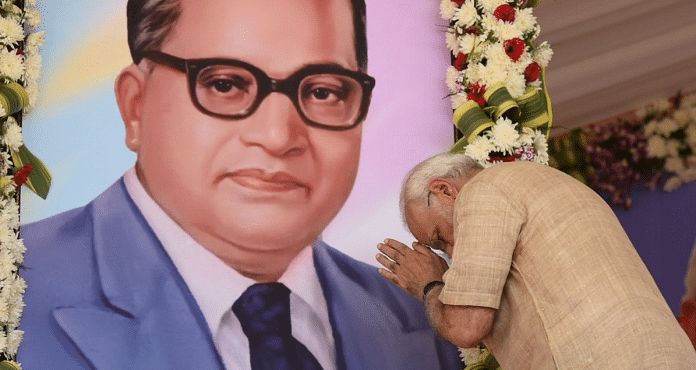S.P. Mookerjee and B.R. Ambedkar were colleagues in Jawaharlal Nehru’s first government, but never had a cordial relationship.
The first item on Prime Minister Narendra Modi’s carefully curated Twitter timeline this Friday morning was a photograph of Jana Sangh founder Syama Prasad Mookerjee and Dalit icon B.R. Ambedkar.
“Both were ministerial colleagues and had a futuristic vision for India’s growth,” the tweet says.
The picture tells a fascinating story, and not only because the PM’s social media team is playing with history.
Mookerjee and Ambedkar were certainly colleagues in Jawaharlal Nehru’s first government, until each went their own way in 1951.
Mookerjee left Nehru to found the Jana Sangh, while Ambedkar quit the cabinet because he was upset the Congress was not willing to accept an egalitarian Hindu Code Bill.
But Ambedkar and Mookerjee never really had a cordial relationship. The Dalit leader had for several years begun to write very strongly against caste Hindu leaders who believed that lower castes should be shunned.
The objectives of the Hindu Mahasabha, which protested conversions (the philosophy of ‘shuddhi’ or purification), and those of Ambedkar’s Scheduled Caste Federation (SCF) were well-known. Ambedkar himself would later convert to Buddhism.
In fact, even on the question of Pakistan, Ambedkar differed significantly from the RSS and the Mahasabha. In his 400-page treatise, ‘Thoughts on Pakistan’, which he wrote soon after the 1940 Lahore resolution on an independent Muslim state was passed, Ambedkar said “Hindus should concede Pakistan to the Muslims.”
Ambedkar’s unease with the Congress
Ambedkar’s uneasy relationship with the Congress party was not confined to his quarrel with Mahatma Gandhi over the treatment of the depressed classes. Strongman Sardar Patel refused to allow Ambedkar to be elected to the Constituent Assembly of India from Bombay, perhaps because of his rising popularity.
Patel – Modi’s role-model – told Bombay premier S.G. Kher not to help with the five votes needed for election to the Constituent Assembly.
In what constitutes another fascinating twist, Ambedkar went to Bengal in 1946. He was invited there by fellow member of the SCF, Joginder Nath Mandal, very close to Muslim League leader Hussain Suhrawardy and a member of his Bengal government. After partition, Mandal, in fact, was Pakistan’s first law minister. He returned to India after Jinnah died.
Mandal, who belonged to the lower-caste Namasudra community, believed that an alliance between Dalits and Muslims was unstoppable. So he got Ambedkar the remaining four votes needed from Scheduled Caste leaders, including two from the Congress, to have Ambedkar elected.
Dalit leader Mayawati today has the same ideas. Her rainbow victory in 2007 was in no small measure down to winning over the Muslims.
Co-opting Dalits and their icon
Narendra Modi and Amit Shah realise that a Dalit-Muslim alliance on the one hand and an OBC-Dalit caste combination on the other would spell doom for the BJP in the general elections of 2019.
Modi’s wooing of the Dalits has been going on for some time. The BJP’s co-option of the Dalits helped pull off its spectacular victory in the UP elections in 2017. The question now is how to retain that vote.
Nor can Modi allow Ambedkar’s distaste for caste Hindus to become too public. In an interview to the Swarajya web portal earlier this week, the PM noted that funds for SC/ST programmes have gone up by 41 per cent, and that the five places Ambedkar lived in will be called the “Panchteerth”.
The PM knows that he must try and keep Dalits away from the opposition – even if the BJP can’t fully retain their loyalty.
There is also much emphasis on Ambedkar’s opposition to Article 370, like the BJP today, as well as the fact that he was, like the BJP, in favour of a uniform civil code.
The Friday morning tweet by Modi is carefully crafted. It doesn’t say that Mookerjee and Ambedkar got along; only that both had a “futuristic vision” for India.
The Prime Minister and his aides know the mixed bag on the governance front is certainly not enough to win another five years. Modi’s interview to Swarajya reads like a PIB press release – building 100 lakh rural houses, increasing the disabilities job quota from 3 to 4 per cent, raising the budget of SC/ST ministries to Rs 95,000 crore, etc.
Along with the caste card – which all sides will play with abandon in the coming elections – the PM’s need to debunk the Congress remains strong. “I am not ashahenshah,” he said, adding that it was the BJP which fought the Congress party’s Emergency tooth and nail.
“In fact, if you look at India’s history since 1947, it is the Indian National Congress that has subverted our democracy, judiciary and media, time and again,” he said.
Ambedkar may have had several problems with the Congress, but it’s a sure shot that he would never have agreed with a statement like the one the Prime Minister made.




Wondering how Mamata winning West Bengal makes her national leader. She has no following other than in West Bengal. To be national leader, you need following all over India.
Very high up on the agenda to win the trust and affection of the Dalits should be a heightened sense of security and well being for them on the ground. Events taking place on an almost daily basis, shared globally on WhatsApp, are not helping the party’s Dalit outreach. 2. Why the bag on governance should be mixed remains an enduring mystery.